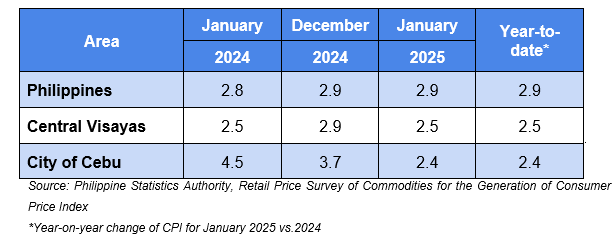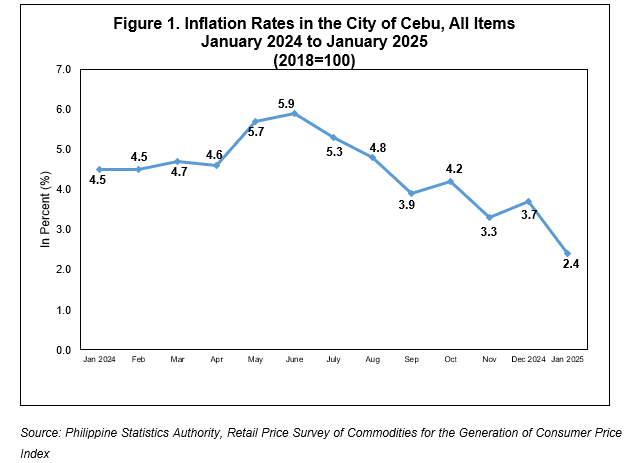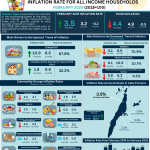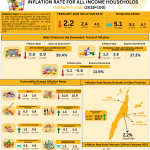Starting February 2022, the Philippine Statistics Authority (PSA) released the rebased Consumer Price Index (CPI) for all income households to base year 2018, from base year 2012 as announced in the press release number 2022-01 dated 04 January 2022. The CPI series for all income households for January 2022 onwards will be 2018-based.
Table A. Year-on-Year Inflation Rates, All Items
In Percent
(2018=100)


A. The Philippines
The Philippines’ headline inflation or overall inflation in January 2025 remained at 2.9 percent, the same annual growth rate recorded in December 2024. Inflation in January 2024 was posted at 2.8 percent. (Table A)
B. Central Visayas
1. Regional Inflation
Headline inflation in Central Visayas decreased to 2.5 percent in January 2025 from 2.9 percent in December 2024. Inflation in January 2024 was posted at 2.5 percent. (Table A)
C. City of Cebu
1. Headline Inflation
In January 2025, the headline inflation in City of Cebu had a slower increase of 2.4 percent from 3.7 percent in December 2024. The inflation rate in January 2024 was posted at 4.5 percent. (Table A and Figure 1)
1.1 Main Drivers to the Downward Trend of the Headline Inflation
The downtrend of the headline inflation in January 2025 was primarily influenced by the no price movement of housing, water, electricity, gas and other fuels at 7.1 percent from 7.1 percent in December 2024. Also contributed in the city’s headline inflation was the slower year-on-year increase of restaurants and accommodation services at 0.9 percent from 1.8 percent in the previous month. (Table 3)
Faster annual decrease was noted in transport at 0.6 percent in January 2025 from 0.4 percent annual increase in December 2024. (Table 3)
In addition, slower annual increments were posted in the following commodity groups during the month:
a. Health, 2.9 percent from 3.5 percent;
b. Education services, 4.5 percent from 5.0 percent;
c. Clothing and footwear, 0.9 percent from 1.0 percent; and
d. Recreation, sport and culture, 0.8 percent from 0.9 percent. (Table 3)
In contrast, faster annual increases were recorded in the indices of food and non-alcoholic beverages at 4.8 percent, alcoholic beverages and tobacco at 1.3 percent and personal care, and miscellaneous goods and services at 3.8 percent from their previous month’s respective inflation rates at 2.6 percent, 0.6 percent and 3.5 percent. (Table 3)
Moreover, financial services had no price movement during the month from 0.3 percent decline in December 2024. (Table 3)
Meanwhile, furnishings, household equipment and routine household maintenance, and information and communication retained their previous month’s respective inflation rates at 10.9 percent and 1.3 percent. (Table 3)
1.2 Main Contributors to the Headline Inflation
The top three commodity groups contributing to the January 2025 headline inflation were the following:
a. Food and non-alcoholic beverages with 65.3 percent share or 1.6 percentage points;
b. Furnishings, household equipment and routine household maintenance with 13.1 percent share or 0.3 percentage point; and
c. Personal care, and miscellaneous goods and services with 6.4 percent share or 0.2 percentage point.
2. Food Inflation
The food inflation in the City of Cebu had a faster increase of 5.1 percent in January 2025 from 2.8 percent in December 2024. In January 2024, the food inflation stood at 6.7 percent. (Table 7)
2.1 Main Drivers to the Upward Trend of Food Inflation
The acceleration of food inflation in the city was mainly brought by the faster year-on-year increases of fish and other seafood at 10.8 percent and meat and other parts of slaughtered land animals at 7.8 percent from their previous month’s respective inflation rates 0.7 percent and 6.4 percent. Also contributed in the acceleration of city’s food inflation was the faster annual increase of vegetables, tubers, plantains, cooking bananas and pulses at 14.2 percent from 0.7 percent annual decline in December 2024. (Table 5)
In addition, slower annual decrease was recorded in sugar, confectionary and desserts at 2.5 percent in January 2025 from 2.7 percent annual decline in December 2024. (Table 5)
On the other hand, slower annual increments were posted in the following food groups during the month:
a. Rice, 1.8 percent from 2.0 percent;
b. Corn, 27.0 percent from 27.8 percent;
c. Fruits and nuts, 2.3 percent from 6.7 percent; and
d. Ready-made food and other food products not elsewhere classified, 4.5 percent from 4.9 percent. (Table 5)
Faster annual decrease was noted in milk, other dairy products and eggs at 0.3 percent in January 2025 from 0.3 percent annual increase in December 2024. (Table 5)
Furthermore, flour, bread and other bakery products, pasta products, and other cereals, and oils and fats retained their previous month’s respective inflation rates at 0.9 percent annual increase and 2.0 percent annual decline. (Table 5)
2.2 Main Contributors to the Food Inflation
Food inflation shared 63.4 percent or 1.5 percentage points to the overall inflation in January 2025. The top three food groups in terms of contribution to the food inflation during the month were the following:
a. Fish and other seafood, with 32.3 percent share or 1.7 percentage points;
b. Meat and other parts of slaughtered land animals with 31.0 percent share or 1.6 percentage point; and
c. Cereals and cereals products, which includes rice, corn, flour, bread and other bakery products, pasta products, and other cereals, with 18.3 percent share or 0.9 percentage point; and
Table B. Year-on-Year Inflation Rates in the City of Cebu, All Items
In Percent
January 2020 – January 2025
(2018=100)

Approved by:
MELCHOR B. BAUTISTA
Chief Statistical Specialist
KST/MJG




